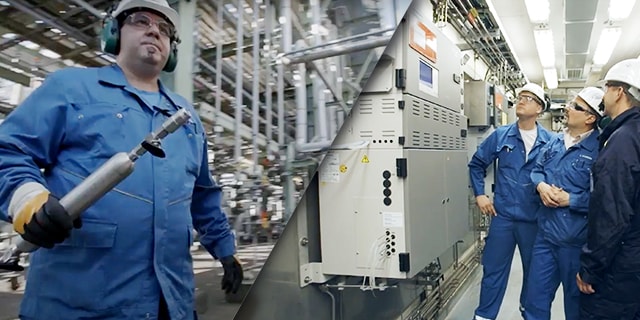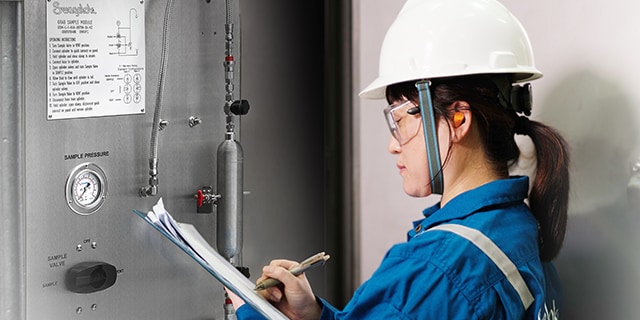Global Construction Grab Sampling

Large-Scale Industrial Construction: How to Optimize Grab Sample Quality, Safety, and Profitability
Managing the construction of large-scale facilities, such as chemical refineries, wastewater treatment plants, manufacturing sites, and oil and gas platforms, is inherently difficult. Thousands of people are involved, competition is aggressive, and logistics are complicated. Amid the complexities of these large-scale projects, best practices in industrial fluid system and grab sampling system design are often overlooked.
Industrial construction often starts with a preapproved schematic of the fluid system that is given to a subcontractor to build on-site according to the design. By taking this standardized approach, some of the finer details might not be addressed at the start, resulting in future challenges for operators when it comes to sample quality, safety, and environmental protection.
While every fluid system is different, there are important considerations that need to be made upfront to avoid issues in the future.
 The Importance of Proper Grab Sampling Design
The Importance of Proper Grab Sampling Design
Grab sampling is a process by which a sample is extracted from a fluid system for remote laboratory analysis. The samples are used to test the quality of the fluid to determine if it meets set standards at different locations in the facility, including near storage containers, on long transport lines, on process lines, and at flare locations. They are also used before and after transportation, especially when there is a change of custody, to determine the value of the cargo.
External factors can have an impact on the sample and misrepresent quality or true process conditions—and can cost money if the sample is of poor quality. Your system design should ensure your samples are:

1. Timely – It is important to minimize the time it takes your sample to travel from the process line to the sample container, helping to reduce the opportunity for external factors to interfere with the sample
2. Representative – The sample should be representative of the process fluid to provide useful analysis
3. Compatible – The system materials of construction need to be compatible with the sample to minimize maintenance and repairs over the life of the system
It is also critical to ensure that the sample is handled properly. Sampling a liquid from a high-pressure source can lead to spillovers of the process fluid, which is wasteful and potentially dangerous for the operator and the environment.

Tips for Establishing Effective Grab Sampling Systems in New Construction
As mentioned previously, some of the key elements of proper system design can be overlooked in the standardized approaches, leading to future problems. At the onset of large-scale construction projects, there is an opportunity to construct grab sampling systems that follow best practices and are well positioned for future success.
To ensure the grab sampling system is going to provide samples that are timely, representative, and compatible, it is helpful to enlist the support of experienced advisors to help in the following areas:
Assisting with Probe Selection
Achieving the optimal level of accuracy starts with properly extracting the sample from the process tube or pipe. An advisor can help determine the ideal location, as well as help to select the right size of probe for your application. They can also help by performing specific calculations to establish the appropriate length, diameter, and system design.
Determining Grab Sample Location and Grab Sample Panel Placement
For best results, grab sample points should be strategically located on the process lines. For the future safety of operators, it is also important to remember to place the grab sample panel in an area that it easily accessible to operators and that it is not too high or difficult to reach.
Conducting Temperature and Pressure Calculations
One oversight that can occur in the construction of the fluid system is making sure that specific calculations are completed that will help maintain sample quality. Temperature and pressure calculations, such as Joule-Thompson (J-T) calculations, should be conducted to predict the temperature effects of pressure changes and that the sample doesn’t change phase. For example, if the pressure drops causing the gas to cool past its dew point, liquid will form, which changes the composition of the sample.
Conducting Purge-Time Calculations
Fully purging the sample nozzle, probe, transport lines, and panel between uses helps to reduce the potential for any lingering fluid to compromise the next sample. Calculations should be completed to figure out how long the system needs to be purged to get a fresh sample.
There are several other calculations that an adviser can assist with to ensure the quality and safety of the sampling system, including time-delay calculations and phase change calculations for different fluid mixtures.
Enlisting Support of Experienced Advisors for Global Construction Projects
Ideally, fluid system and grab sampling advisors should be brought in prior to the construction of the line to consult on best practices for the layout of the system and to complete the necessary calculations to deliver the best sampling results. Swagelok advisors and engineers can work on-site during construction to help make the complex process of large-scale projects run smoother and ensure the completed fluid system will follow best practices for quality, safety, and profitability.
Related Articles

Analyzing Your Sampling Needs
Trying to determine whether grab sampling or online analysis is the best option to monitor your process conditions? We put together a convenient checklist to help guide you to a solution that suits your operations.

Safe, Representative Gas Grab Sampling
Read about common challenges associated with volatile liquid and gas grab sampling and learn to overcome them by using the right techniques and appropriate equipment.

Standardizing Fluid System Components on Megaprojects
Swagelok’s global construction services can help oil and gas owner operators realize major operational benefits by standardizing fluid system components used across the site. Learn more about the advantages of standardization.




